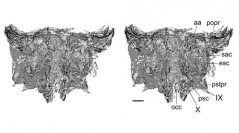

 Comptes Rendus Palevol
9 (6-7) - Pages 289-309
Comptes Rendus Palevol
9 (6-7) - Pages 289-309Labyrinth morphology in extant elasmobranchs (neoselachians: sharks, skates and rays) and several extinct chondrichthyans ranging in age from Pliocene to Devonian is investigated using high-resolution computed tomography (CT scanning) and digital reconstitution techniques. The elasmobranch labyrinth is highly specialized toward low-frequency semi-directional sound detection (LFSDP), optimally around 100 Hz. Several features associated with LFSDP in neoselachians also occur in Mesozoic hybodonts (e.g., Egertonodus, Tribodus) and in some incertae sedis extinct sharks (Acronemus, Tristychius), but are absent in osteichthyans, extant and fossil holocephalans, and certain Paleozoic chondrichthyans (ctenacanths, symmoriiforms, Pucapampella). Thus, LFSDP is regarded as an evolutionary novelty of elasmobranchs that arose some time after their divergence from chimaeroids. The suite of characters associated with LFSDP was probably acquired progressively, some characters being more widely distributed among fossil chondrichthyans than others. LFSDP evolved only within chondrichthyans whose otico-occipital fissure became secondarily closed during ontogeny.
Chondrichthyes, Phonoreception, CT scanning, Paleontology, Labyrinth